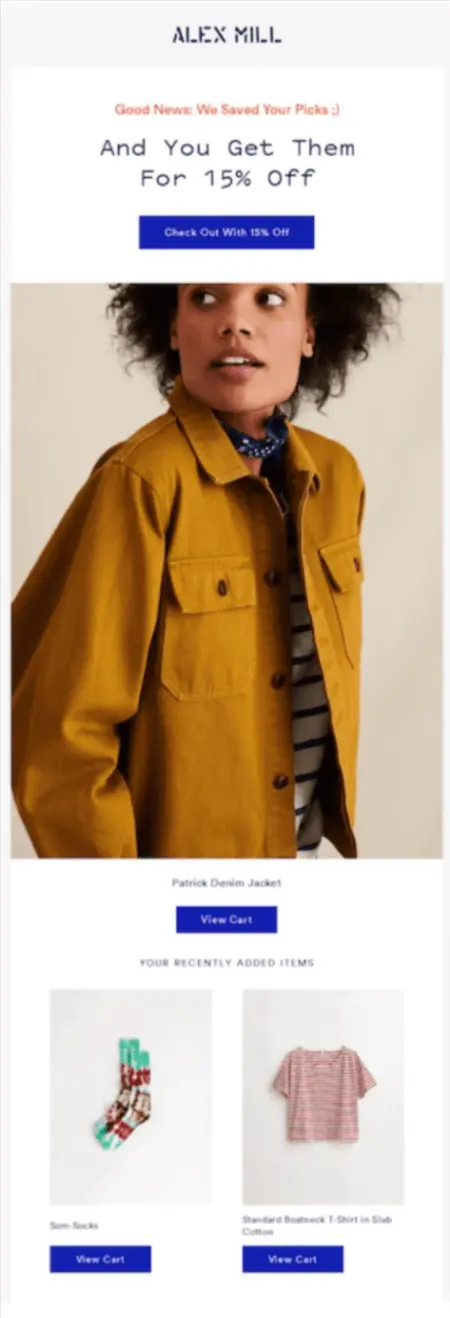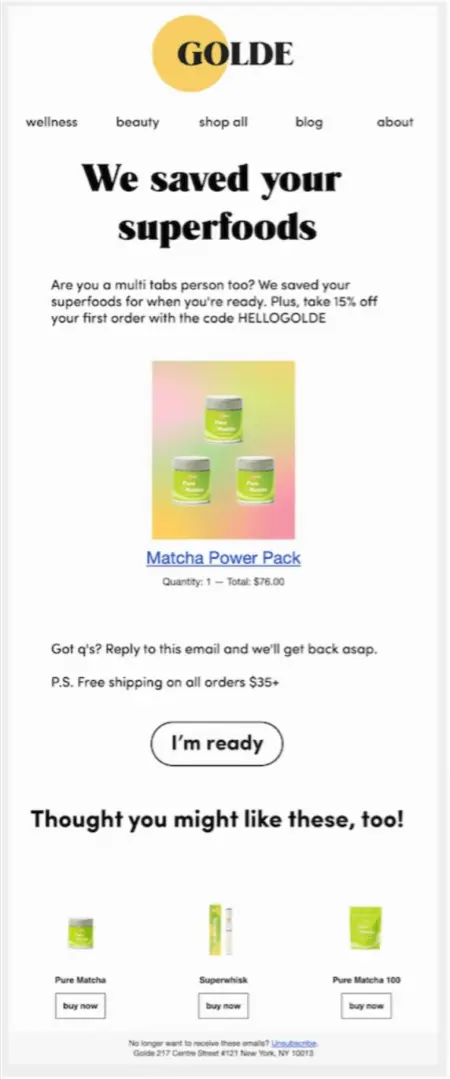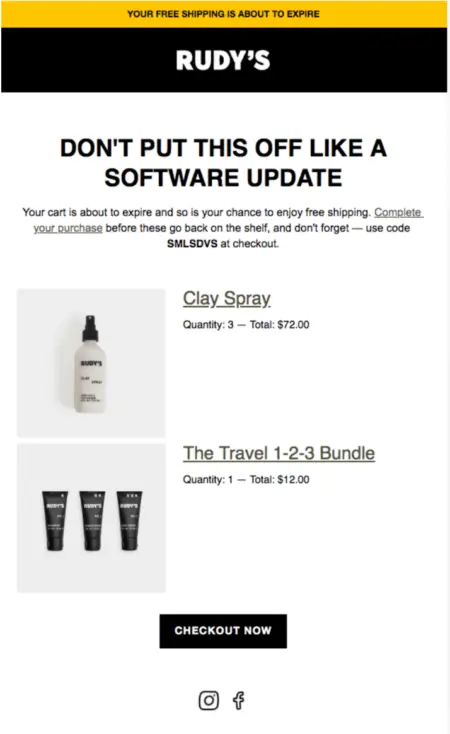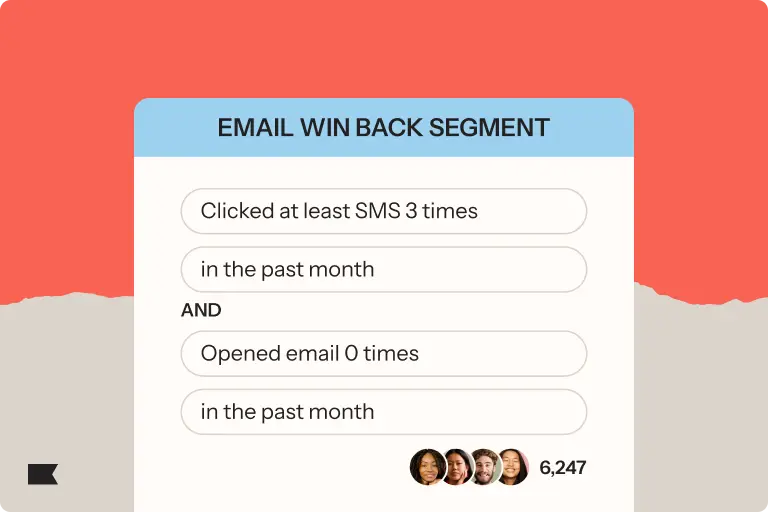Abandoned cart emails: components and best practices, with 7 examples
Abandoned carts are an inevitable part of running a B2C brand.
70% of online shopping carts are abandoned, according to a meta-analysis by the Baymard Institute.
That means no matter how attractive your store or how flawless your product, the majority of your customers will likely abandon their online shopping carts.
There are many reasons for this. Some of them are in your control—shipping fees, website errors. And some of them aren’t—readiness to buy, economic conditions, everyday distractions.
Here, we walk you through the basics of the abandoned cart—why people don’t complete a purchase, the importance of abandoned cart emails, and how each component of these emails works to nudge people toward a sale.
If you already have a baseline understanding of abandoned carts, skip to the end to learn some best practices illustrated by real-world examples.
What is an abandoned cart email?
An abandoned cart email is an automated message triggered when an online shopper places an item in their cart and doesn’t complete a purchase. It re-engages shoppers by reminding them about the products in their cart and enticing them to complete their purchase. You can send one-off cart abandonment emails, or create a series of automated emails.
Customers often visit online stores and browse products they like. But when they add a product to their cart, they demonstrate a desire to actually buy it, which reveals a high intent to purchase.
This is extremely valuable information for brands. When you know someone is close to buying, you can not only send them an abandoned cart flow, but also place them in a highly engaged audience segment. If they don’t end up buying from your abandoned cart email, you’ll still know they’re close to buying, which means you can send them other offers and promotions down the line.
Abandoned cart emails and data privacy
A common misconception about abandoned cart emails is that they’re illegal and don’t comply with data privacy regulations.
But instead of third-party data—consumer information you collect indirectly from a variety of sources, such as marketplaces and ad networks—abandoned cart emails use first-party data—online behavioral data you observe after someone gives you consent to contact them via email or SMS.
Marketing to customers using data you collect with their explicit consent, such as the information they offer up when they sign up to your mailing list, is legal and compliant with data privacy requirements.
Why do people abandon their shopping carts?
The meta-analysis by the Baymard Institute found that nearly 43% of shoppers ditch carts because they’re either “just browsing” or “not ready to buy.” But when they excluded this segment of people, Baymard also found that people don’t buy because:
Shipping and other fees are too high
Online shopping doesn’t jive well with the unexpected—and if shipping or other fees are too high, it’s a surprise that triggers extra consideration.
When high shipping and handling fees significantly increase the overall cost of an online purchase, customers may perceive the final price as too expensive compared to the product’s initial cost. This leads to hesitation, which oftentimes leads to cart abandonment.
To prevent this from happening, offer free shipping thresholds or simply fold shipping costs into the price of the product. And if shipping costs are a big reason people are abandoning your carts, consider offering free shipping as an incentive in your abandoned cart email.
The product delivery estimate is too slow
Blame Amazon—people want their products fast. We’re not saying you need to offer same-day delivery to keep abandoned cart rates low, but your delivery estimates do need to be timely so more people complete their purchases.
A slow delivery estimate can outweigh someone’s immediate desire for the item—and as a result, shoppers will seek competitive alternatives that can deliver more quickly.
To prevent this from happening, offer a range of shipping options—including, most importantly, expedited services. Sometimes people are willing to pay more for faster delivery, and if they aren’t, you can offer those incentives for free in your abandoned cart email for high-value carts.
They don’t trust the website with their credit card information
Credit card scams are on the rise. According to The Motley Fool, there were 65% more reported cases of credit card fraud in 2024 than in 2019.
Many people are sensitive to this knowledge and are constantly on the lookout for scams that can compromise their credit card. If a website seems to lack security measures, like SSL certificates or trust badges, customers may feel their sensitive information is at risk, leading them to leave without completing their purchase.
Here are a few ways to reduce this kind of cart abandonment:
- Ensure robust credit card encryption, such as requesting CVV number.
- Display security certifications prominently.
- Provide clear information on privacy policies and data handling practices.
The returns policy isn’t satisfactory
Just like cart abandonment, returns are an inevitability of ecommerce. According to data gathered by Invesp, at least 30% of all products ordered online are returned, compared to 8.89% in brick-and-mortar stores.
But here’s why you should make that process as easy as possible: according to Klaviyo’s 2025 future of consumer marketing report, 50% of consumers are convinced to give a brand a second chance after a negative experience if they’re offered compensation such as a refund, discount, or replacement.
Before they even buy, people will abandon their carts in the face of an unclear or restrictive returns policy. Half the battle of persuading someone to buy from your brand is reassurance—and a lack of reassurance that people can return products easily leads to hesitation at check-out.
While your website should feature transparent language about your returns policy, your abandoned cart email can also reinforce a smooth process for returns if you’re seeing this as a large reason people abandon their carts.
There aren’t enough payment methods
If someone can’t find their preferred method of payment, they’re a lot more likely to abandon their purchase.
Especially now, with so many convenient payment options—many of which don’t require much more than a CVV number entry and a click—it’s standard practice to offer a lot of payment methods, such as:
- PayPal
- Apple Pay
- Venmo
- Google Pay
- Amazon Pay
Online retailers should integrate multiple payment solutions, including credit cards, digital wallets, and alternative payment methods, for a seamless and inclusive shopping experience.
Components of an effective abandoned cart email
Attention-grabbing subject line
The easiest way to grab attention is by personalizing subject lines using customer profile properties like someone’s name, the products they left in their cart, or an offer tailored to any past browsing behavior.
You may want to go with something simple like, “Alex, run faster with the shoes you left behind,” but someone’s browsing behavior may indicate they’re shopping an entire category—in that case, something like, “Here’s 10% off all running apparel” may be the nudge someone needs to make a final decision to buy.
Product details
Product details about the item someone left behind should make up the bulk of your email copy. List key details like price, size, and color, and always include an image of the product.
Personalization
True personalization goes beyond featuring the recipient’s name and their specific abandoned items. Today, that’s table stakes.
With a B2C CRM like Klaviyo, you can take personalization to the next level by combining multiple data sources to create a hyper-relevant abandoned cart email experience. Personalize your incentives and offers based on factors like:
- Cart value: Offer incentives only for high-value carts.
- Browse abandonment or previous purchase history: Include additional product recommendations based on the product pages someone’s viewed or the products they’ve purchased.
- Loyalty or rewards points: Include someone’s unique points number or tier in the email and encourage them to use their rewards on their purchase.
- Customer support interactions: Exclude customers with open tickets from receiving an abandoned cart email.
Call to action (CTA)
A clear and compelling CTA is what leads the recipient back to their cart on your website to complete the purchase. It should stand out with a distinct color and use action-oriented language, like “Complete Your Purchase” or “Return to Cart,” or maybe “Claim Your Offer” if you’re offering a good incentive.
Incentives and offers
Discounts, free shipping, or a limited-time offer are often the nudges a customer needs to go through with their purchase. Your incentives should address your brand’s most common barriers to completing a sale, like cost of the product or cost of shipping.
If it doesn’t make sense for your brand’s economics to offer an incentive for every abandoned cart, consider segmenting high-value carts and only offering an incentive on those where you stand to make more revenue from a single purchase.
Social proof
User-generated content in the form of customer testimonials, reviews, or ratings can build trust and get ahead of concerns. In addition to a solid product image with robust details, social proof is a great way to tip the scales toward a sale.
Urgency or scarcity
Urgency is a great way to persuade people to buy. Consider time-limiting your incentives by offering a personalized discount code, and include a countdown timer that shows when it expires.
Alternative product recommendations
If someone doesn’t complete a purchase, it may just be that they need to see alternatives before buying. Suggest related products, or showcase similar items other shoppers have bought, to provide a wider range of options.
12 abandoned cart email best practices, with examples
1. Start with understanding why your shoppers abandon their carts
Think through your customer’s experience. When they’re shopping on your website, what’s the most likely reason they abandon their cart?
Earlier we mentioned some of the most common reasons why people abandon their carts. You can glean whether some of these reasons apply from website heatmap tools like Hotjar, which makes it easy to observe user interactions on check-out pages. You may also want to consider trialing a survey within your abandoned cart flow, and seeing if you can diagnose cart abandonment that way.
Another option is to run some A/B tests on your check-out pages as a diagnostic tool. If you do, remember to make only one change at a time. Changing too many variables at once will obscure results, and you want to see a definitive increase or decrease in completed purchases as you test different theories.
2. Personalize abandoned cart emails based on purchase history, cart size, and product preferences
Before you start crafting the content of your abandoned cart emails, make sure you understand and implement trigger splits and conditional splits.
Similar to customer segmentation, adding splits to your flows allows you to personalize your abandoned cart email messaging based on event and profile data such as purchase history, cart size, and product preferences.
“Sometimes, the best way to turn a missed sale into a conversion is by highlighting items a shopper may have missed,” says Sharon Goldstein, former CEO of LimeSpot.
“Including personalized product recommendations in an abandoned cart email can turn heads and drive much higher click rates as shoppers investigate new finds that align with what they’ve already shown an interest in,” Goldstein adds.
In this abandoned cart email, DTC grooming brand Beardbrand does a great job following this advice. Notice how they not only use personalized copy and a friendly tone to inspire shoppers to “reclaim” their cart, but also keep the product front and center, with distinct CTAs to draw the recipient’s eye.

Source: Really Good Emails
The challenge with abandoned cart personalization is that there’s no one-size-fits-all strategy. Analyze your performance periodically to find the best approach.
It’s also important to filter out everyone who has abandoned a cart recently. Hitting these inboxes too frequently can annoy subscribers and increase opt-out rates.
3. Write a subject line that stands out in the inbox
A shopper can’t click on your email if they don’t open it. And they’re more likely to open it if you give them a subject line to care about.
Grab attention in crowded inboxes with smart, streamlined subject lines. Abandoned cart emails are a great place to experiment with clever copy and tone—as long as it makes sense for your brand. Here, watch how beverage brand Liquid Death gets a shopper’s attention with dark humor.

Image source: Really Good Emails
4. Align your email copy to your brand voice
An abandoned cart email’s objective is to nudge shoppers toward a purchase. Keep your email copy short and limit punctuation, but don’t shy away from your brand’s tone and voice so that customers can get to know you through your abandoned cart email.
In this abandoned cart example, sustainable activewear brand Girlfriend Collective uses a minimalistic email template with clever copy: “Looks like you left something cute and sustainable in your cart. Don’t worry, we saved it for you.”

Image source: Girlfriend Collective
“This abandoned cart email from Girlfriend Collective is *chef’s kiss,*” says Alex McPeak, content marketing lead at Klaviyo. “I love the deviation from ‘you forgot something/left something behind’ with ‘you dropped this’ and how they hammer home the sustainability aspect, which is core to their brand.”
5. Feature high-quality product shots of the abandoned product
By the time shoppers see your email, a million other thoughts could be consuming their mind—and your product won’t be a priority. To entice recipients to engage with your product page again, you’ll need to make it look really good with a high-quality product shot.
In this cart abandonment email, apparel brand Alex Mill uses most of the available real estate to highlight abandoned items with high-quality product images, then complements those with an enticing discount to drive conversions.

Image source: Alex Mill
6. Mix in some social proof
Social proof can influence buying decisions by communicating your products’ value. More importantly, it can help you earn the trust of shoppers who aren’t familiar with your brand—according to Klaviyo’s future of consumer marketing report, customer reviews are the most influential factor when someone is making an initial purchase with a brand.
But you can also include star ratings and even social media mentions to convey authenticity and build trust. This cart abandonment email from Kim Kardashian’s shapewear brand, SKIMS, uses both star ratings and customer reviews.

Image source: SKIMS
7. Offer discount codes…
Personalized and limited-time discounts are a timeless strategy for creating a sense of urgency and increasing conversions in an abandoned cart flow. And in the face of economic volatility, they’re more important than ever—according to Klaviyo’s future of consumer marketing report, economic conditions have led 37% of consumers to seek out discounts and promotions from retail and ecommerce brands in the last 6 months.
The added benefit of offering a coupon code to abandoners is that it doesn’t reduce the value of your brand upfront.
A word of caution: Offering discounts to repeat cart abandoners can work against you by training them to wait for a discount before buying. One way to overcome that is by providing one-off discounts, like health and beauty brand Golde does here for new customers.

Image source: Golde
And if it really doesn’t make sense for your business economics to be throwing around discount codes for every abandoned cart, consider segmenting high-value carts and only offering an incentive on those where you stand to make more revenue from a single purchase.
8. …or consider offering free shipping instead
According to Baymard, the reason 39% of cart abandoners walk away is that extra costs, like shipping, are too expensive. It stands to reason, then, that offering free shipping may push them over the line to purchase.
Belle Murray, former ecommerce senior strategist at SmartBug Media, suggests this strategy as a way to do more than simply remind your customers that they left without buying: “Introduce a free shipping offer toward the end of your abandoned cart automation.”
“Shipping cost is a very common reason customers leave before completing their purchase,” says Murray. “A one-time free shipping offer is a great way to give them a nudge to place their first order. Keeping it at the end of your automation with engagement filters will help target engaged subscribers that are still on the fence about purchasing.”
Here, hair and bodycare brand Rudy’s offers free shipping to cart abandoners, highlights the offer at the very top, and includes a clear message about the offer’s urgency.

Image source: ReallyGoodEmails
9. Use a convincing CTA
The call to action (CTA) is one of the most important parts of your cart abandonment email. It gives your customers clear instructions about what they need to do next—return to their cart and complete their purchase.
Some traditional, clear CTAs for abandoned cart emails include:
- Buy now
- Shop now
- Keep shopping
- Return to cart
- Proceed to check-out
- Finish checking out
- Check out now
- Complete your order
If you’re offering a discount or free shipping to get someone back to their cart, consider making that the CTA:
- Activate free shipping
- Get my 10% off
- Reveal new price
If your brand wants to come off a little softer, consider a less aggressive CTA for your abandoned cart email:
- Take a closer look
- View cart
- Take another look
If your brand’s voice is cheeky or conversational, now is a great time to have fun with the CTA:
- Let’s do this
- Finish the job
- Seal the deal
- Treat yourself
10. Send multiple emails as part of an abandoned cart flow—but test it first
A cart abandonment email doesn’t have to be an isolated message. You can also create an abandoned cart series.
A simple abandoned cart email sequence might look something like this:
- Email 1: Remind customers about the products in their cart.
- Email 2: Send a follow-up email with a discount.
- Email 3: Share a product recommendation.
Email marketing pro Chase Dimond shares that in his experience, “having multiple abandoned cart emails results in 69% more orders than a single abandoned cart email.” But every brand is different, so always A/B test this for yourself.
11. Send your first email 2–4 hours post-abandonment
Timing your emails correctly is always crucial to success—and nowhere is that more true than the abandoned cart flow.
Don’t send an email too soon after your customer abandons their cart. Whatever distracted them from their purchase might still exist. And if it does, your email might end up buried deep in their inbox or straight in the trash.
Send your first reminder 2–4 hours after abandonment, and keep it simple. You want it to feel organic and friendly.
If your customers don’t engage with your first email, consider sending another reminder 24–48 hours after that. You can make the second reminder a bit more salesy, or work in a personalized offer to amplify its impact.
If shoppers don’t respond to 2–3 emails, they’ve likely completed their purchase somewhere else or abandoned it entirely.
At this stage, sending a third sales-oriented email might not help. Instead, send an exploratory email to suggest popular items or related products and lay the foundation for a future sale.
12. Incorporate SMS in your abandoned cart flows
For a high-intent flow like abandoned cart, SMS is often a great channel for adding urgency to messages. You can complement an abandoned cart flow with SMS to make sure you’re communicating with your audience on the channel they prefer most.
If you’ve collected your customers’ phone numbers and SMS consent, send a quick text reminding them about the products they left behind. That might be the push they need to follow through with their purchase.
Important note: if you’re sending abandoned cart texts to US recipients, you must adhere to the following requirements:
- Use double opt-in when collecting SMS consent.
- Only send one SMS per recipient.
- Send the text within 48 hours of someone abandoning a cart.
Learn how to set up an abandoned cart flow in minutes
One of the best things about abandoned cart flows is that they’re automated. That means when someone abandons a cart on your website, you don’t need to manually send an email.
Learn how to set up an abandoned cart flow in Klaviyo with dynamic content blocks, time delays, templates, and even SMS.
These abandoned cart flows are able to work the way they do because they draw from customer data housed in Klaviyo B2C CRM—the CRM built for the unique needs of B2C businesses. When you bring together customer data, marketing, service, and analytics into a single platform, you can:
- Segment high-value carts from low-value carts for a more cost-efficient discount strategy.
- Leverage other browsing behavior for more targeted—and lucrative—product recommendations.
- Equip your customer service agents with more fulsome customer knowledge, so their interactions are informed by past behaviors such as abandoned carts.


Related content

Discover the best email marketing platform for ecommerce in 2026. Compare top tools for data, automation, personalization, and deliverability.

Learn how to use Klaviyo SMS, segmentation, and hybrid flows to re-engage lapsed email subscribers, boost deliverability, and drive higher retention.

Boost D2C email revenue from 12% to 30% with the Klaviyo playbook: high-converting pop-ups, a 5-email welcome series, smart filters, and optimized abandonment flows.